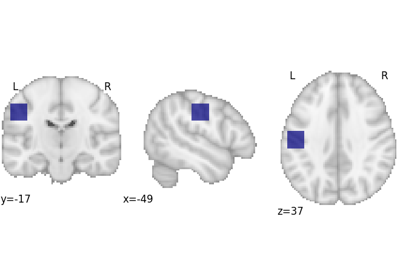nimare.decode.discrete.BrainMapDecoder
- class BrainMapDecoder(feature_group=None, features=None, frequency_threshold=0.001, u=0.05, correction='fdr_bh')[source]
Bases:
nimare.base.DecoderPerform image-to-text decoding for discrete inputs according to the BrainMap method.
New in version 0.0.3.
- Parameters
feature_group (
str, optional) – Feature group name used to select labels from a specific source. Feature groups are stored as prefixes to feature name columns in Dataset.annotations, with the format[source]_[valuetype]__. Input may or may not include the trailing underscore. Default is None, which uses all feature groups available.features (
list, optional) – List of features in dataset annotations to use for decoding. If feature_group is provided, then features should not include the feature group prefix. If feature_group is not provided, then features should include the prefix. Default is None, which uses all features available.frequency_threshold (
float, optional) – Threshold to apply to dataset annotations. Values greater than or equal to the threshold as assigned as label+, while values below the threshold are considered label-. Default is 0.001.u (
float, optional) – Alpha level for multiple comparisons correction. Default is 0.05.correction (
stror None, optional) – Multiple comparisons correction method to apply. Corresponds to available options forstatsmodels.stats.multitest.multipletests(). Default is ‘fdr_bh’ (Benjamini-Hochberg FDR correction).
See also
nimare.decode.discrete.brainmap_decode()The associated function for this method.
References
Amft, Maren, et al. “Definition and characterization of an extended social-affective default network.” Brain Structure and Function 220.2 (2015): 1031-1049. https://doi.org/10.1007/s00429-013-0698-0
- fit(dataset, drop_invalid=True)[source]
Fit Decoder to Dataset.
- Parameters
dataset (
nimare.dataset.Dataset) – Dataset object to analyze.drop_invalid (
bool, optional) – Whether to automatically ignore any studies without the required data or not. Default is True.
- Returns
nimare.results.MetaResult– Results of Decoder fitting.
Notes
The
fitmethod is a light wrapper that runs input validation and preprocessing before fitting the actual model. Decoders’ individual “fitting” methods are implemented as_fit, although users should callfit.Selection of features based on requested features and feature group is performed in
Decoder._preprocess_input.
- set_params(**params)[source]
Set the parameters of this estimator.
The method works on simple estimators as well as on nested objects (such as pipelines). The latter have parameters of the form
<component>__<parameter>so that it’s possible to update each component of a nested object.- Returns
self
- transform(ids, ids2=None)[source]
Apply the decoding method to a Dataset.
- Parameters
ids (
list) – Subset of studies in coordinates/annotations dataframes indicating target for decoding. Examples include studies reporting at least one peak in an ROI, or studies selected from a clustering analysis.ids2 (
listor None, optional) – Second subset of studies, representing “unselected” studies. If None, then all studies in coordinates/annotations dataframes not inidswill be used.
- Returns
results (
pandas.DataFrame) – Table with each label and the following values associated with each label: ‘pForward’, ‘zForward’, ‘likelihoodForward’, ‘pReverse’, ‘zReverse’, and ‘probReverse’.
